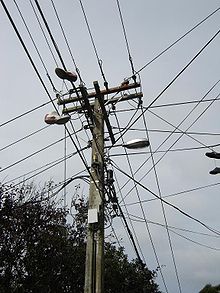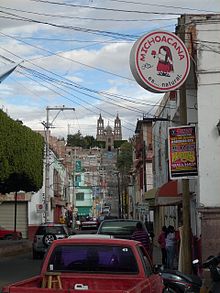- Overhead cable
-
 Pole carrying electricity, Cable TV, and telephone equipment (top to bottom), in New Zealand. Two pairs of shoes can be seen hanging from wires.
Pole carrying electricity, Cable TV, and telephone equipment (top to bottom), in New Zealand. Two pairs of shoes can be seen hanging from wires.
An overhead cable is a cable for the transmission of information, laid on utility poles. Overhead telephone and cable TV lines are common in North America. Elsewhere, overhead cables are laid mainly for telephone connections of remote buildings and temporary mechanisms, as for example building sites. The same poles sometimes carry overhead powerlines for the supply of electric power. Power supply companies may also use them for an in-house communication network. Sometimes these cables are integrated in the ground or power conductor. Otherwise an additional line is strung on the masts.
Cables are arranged on poles with the most dangerous cables, that is, those carrying power, strung highest. Overhead cable systems also include a number of different components for managing signal cables. These include splicing systems that allow multi-conductor cables for distributing telephone signals and snowshoe-shaped devices for reversing the direction of cables.
When metal-based telephone wires are strung on the same utility poles as the power lines, they can pick up noise from the power line. Modern fiber optic telephone cable has the advantage that it can be strung next to power lines without interference.

This article related to telecommunications is a stub. You can help Wikipedia by expanding it.

